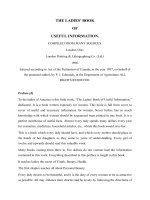The klutz book of knots
Bạn đang xem bản rút gọn của tài liệu. Xem và tải ngay bản đầy đủ của tài liệu tại đây (4.37 MB, 24 trang )
KLUTZ
is a kids' company staffed entirely
by real human beings. We began
our corporate life in 1977 in an office we shared with a Chevrolet
Impala. Today we've outgrown our founding garage, but Palo
Alto, California, remains Klutz galactic headquarters. For those
of you who collect corporate mission statements, here's ours:
• Create wonderful things.
• Be good.
• Have fun.
Write Us
We would love to hear your comments regarding this
or any of our books. We have many!
Visit Us KLUTZ.com
C o m e on in I
KLUTZ
455 Portage Avenue
Palo Alto, CA 94306
Book printed in Korea.
Rope manufactured in Taiwan.
©1985 John Cassidy.
All rights reserved.
Klutz® is a a registered
trademark of Klutz, Inc.
Do You Teach?
Would you be interested in a
classroom set of build-yourown Klutz books? E-mail
, write,
or visit our website for details.
Design, Art Direction and Production:
Design Office Bruce Kortebein
Illustrations: Ed Taber, Heather
Preston, Zahid Sadar
Cover Design and Lettering:
Michael Doret
ISBN 0-932592-10-4
4 1 5 4 2 4 0 7 3 9
Additional Copies and More Supplies
For the location of your nearest Klutz
retailer, call (650) 857-0888. Should
they be tragically out of stock, additional copies of this book and the
entire library of 100% Klutz certified
books are available in our mail order
catalog. Visit our website, Klutz.com.
More Great Books from Klutz
The Book of Classic Board Games
The Buck Book
The Best Card Games in the Galaxy
The Footbag Book
Country & Blues Harmonica for the
Musically Hopeless
Juggling for the Complete Klutz®
The Klutz Book of Magic
Introduction
book about knots is a book
about personal organization
on the real world level,
where shoelaces untie,
packages fall apart, and
clotheslines droop. This
is life's ground floor, the everyday battle
against the small-scale forces of chaos. In
the course of a modern lifetime, it is not
the struggle that receives the most notice,
but it is the one that seems to consume
the most time.
Knots are tools employed in this noble
cause. They are meant to connect and
thus to simplify. Despite the popular misconception, a properly tied knot is generally distinguished by its simplicity and
the ease with which it can be untied, not
by its strength or complexity. Any mixedup tangle of rope can be reasonably
strong but it would be neither appropriate to the job, nor simple to undo. It
would be, as most one-of-a-kind knots
are, an over-elaborate solution to the
problem. And a pain in the neck besides.
There exists, in the knotting literature,
approximately
4,000 different knots,
I n choosing < ^
the 24 that went into
this book,
^ /' we kept to a single
remorse- /
y
less criteria:
Basic,
{ rU
work-a-day,
mal-life, 9-to-5
utility. Remembering that most of our
readers have forsaken the sea, and are
neither woodsmen,
wranglers nor
soldiers of fortune,
we left off such
things as the mulepackers' diamond hitch, an
excellent knot
for loading up trail animals, and included the short-end sheet bend, a
specialist in the repair of broken shoe-
laces. Less romantic perhaps, but occasionally we have to face these kinds
of realities.
But Which Is Really the
BEST Knot?
A true landlubber's question, but one
that is inevitably raised. The correct
answer should be the responsible—
albeit boring—"It depends." Are you
knotting together sheets for an openair exit from a burning hotel? Or are
you tying up your hair?
But let's say you've really only got
room for two or three
knots in
your long-term
memory
files. If such were the
case,
I could be
forced
to recommend the
bowline (#1),
the sheet bend
(#7), and the clove
hitch (#2). The three of them are the class
of the three primary knot categories—
loop knots, rope-to-rope knots (bends),
and rope-to-something-else knots
(hitches). Between them, they should get
you into most binds.
Incidentally, the opposite question,
Which is really the worst knot? is far
simpler to answer. As disillusioning
as this sounds, it's the square
knot, the most over-hyped, understrength knot in creation. Clifford Ashley,
the author of the definitive encyclopedia
on the subject of knotting, states that the
square knot"... has probably been responsible for more deaths and injuries
than all other knots combined."
The reason is that the square knot "capsizes," i.e. it unties itself. A couple of
quick tugs on the rope, or an inadvertent
bump, and the honest square knot turns
into thin air, an unhappy result that demonstrates the difference between a
"strong" knot, one that weakens the
rope the least, and a "secure" knot, one
that resists unraveling. In the normal
course of things, it's "security" that'll
carry the day, not "strength."
A Glossary of Terms
K n o t . Any lump in Bend. A knot jointhe rope.
ing two ropes.
How to use this book
This is a tool-book, that is to say, it is
meant to be more than just read. All
those knots which are designed to be
tied to something, can be tied to the
board pages of this book, next to their
illustrations.
A word of general advice. To the tying of
any knot, there are two parts: one,
crossing the ropes in the right order; and
two, working the knot closed—tightening it. This second part is occasionally
more difficult than the first, and almost
always as crucial. On some knots, the
shoelace bow for instance, all you need
is a simple tug to bring the knot into
place. But on others, the short-end sheet
bend or the bow tie, for example, working the knot shut is practically the
entire problem.
H i t c h . A knot
joining a rope to
something else.
Loop. A knot joining a rope to itself.
Overhand.
nfortunately, it's a
problem that illustrations can only help
with a little, because
it's such a general
"pulling-together"
kind of process. What
it requires is a reasonably clear idea of where the knot is going.
My best advice is to work the ropes
gradually at the final stage, pulling all the
loose ends in turn until you discover
which pull or which tug shapes the knot
in the ways that you want.
Half-Hitch.
Slipped. A "quick
release" modification.
1 The Bowline
If you were marooned on a desert island and
could only take one knot with you, this would be
the one. Properly tied in ordinary rope, there is
little danger of the bowline slipping before the
breaking point of the rope itself is reached—a
comforting thought if you should ever have to tie
a rope around your waist. And nearly as important, the bowline is easy to untie, even after having been dunked in water and put under load.
Like most knots, the bowline's origins were on
board the full-rigged sailing ships where it was
used almost to the exclusion of all other loop
knots, and where it was said that ". . . the devil
himself would make a good sailor, if he could
only tie a bowline and look aloft."
If you should ever have to deal with particularly
thick or stiff materials—a rolled-up bedspread for
example, or anything cable-like, one of the best
ways to join them is with two interlocking bowlines.
2
The Clove Hitch
My favorite nearly-allpurpose hitch. Simple
to tie, simple to untie
and won't jam under
strain. There are
better hitches if you're
especially concerned
about security, and if
you're attaching a rope
to a square s h a p e like a piece of lumber—the clove is not
appropriate, but for
your run-of-the-mill,
tie-this-thing-to-thatpost kind of problem,
the clove is your best
choice.
3
The Two Half Hitches
Note the slipped variation for quick release.
The only other contender for the title of
All-Purpose Hitch.
More common than the
clove, probably because it seems easier
to tie (although it
really isn't). Nevertheless, on shapes and in
places where the clove
won't go, two half
hitches is probably the
best choice, both for
simplicity and security.
The slipped variation
is particularly important, since this knot
can often be tough to
untie without it.
4
A specialist, but a particularly good one. The
tautline hitch is used
mainly when you need
to keep a rope tight
that tends to sag over
time (clotheslines, tent
guys, etc.). The tautline holds in one direction, but can be slid
in the other, when
slack has to be taken
out. It's a one-way
"ratchet" knot, the
best of its kind.
The Tautline Hitch
5
The Better Bow
You only think you know
how to tie your shoes.
The better bow unties
with a simple tug, just
like the soon-to-be-outdated model you have
on your shoes right
now, but the difference
is—it doesn't jiggle
loose. Learn it and
you'll never go back, I
promise.
As the illustrations
show, there's only one
crucial difference between this knot and the
old style. Instead of
taking a single turn
around the middle of
the loops, you'll take
two. Be sure to wrap
your finger, the "hole"
both these turns around it leaves is the place
the end of your finger.
where you push the
When you withdraw
second loop through.
6
This may come as a
minor revelation, but
the knot you tie on your
shoes (old style) is the
same knot you tie
around your neck—at
least the finished product is the same. The
difference is how you
get there.
You can practice with
cord, as per the illustration, but to really get
the idea, you need flat
material, ideally the
real thing. Follow the
steps as illustrated
while remembering that
the trick is in the last
step—pulling the whole
thing into shape.
The Bow Tie
7 The Sheet Bend
Doubled Variation
This is the knot that you thought the square
was—a strong, simple, honest, easy-to-tie connection. One that you can trust. In the same way
that the clove and bowline are, the sheet bend is
an all-star knot, the basic of its category.
The doubled variation is a bit more secure. I'd use
it if something important was on the line.
8 The Square Knot
Originally this was known as the reef knot, used
on board ship to secure the furled-in sails, not a
particularly critical application. Somewhere
along the way, though, it picked up a reputation
for reliability that it most certainly doesn't deserve. As mentioned in the introduction, it is a
rather unstable knot, capable of capsizing if
bumped or jiggled in the wrong way, particularly
if tied in dissimilar materials.
Offsetting these qualities is the fact that you already know how to tie it. As a result, I include it
here for all the lightweight applications, bundle
and parcel wrapping for example.
The surgeon's variation, incidentally, is the one
to use when there's no one around to lend a third
hand when you've got the knot half-tied on top of
some box.
The Surgeon's Variation
10
The Grass Bend
Another specialist. Tied in rope or cord this is
called the whatnot and ranks near the bottom in
terms of security. But in flat semi-flexible material (seat belt webbing, leather belts, etc) it
changes its character entirely. It is, in fact, the
best, if not the only, useful knot for joining this
kind of hard-to-knot material.
As its name suggests, the fisherman's knot is
used quite frequently to join together two pieces
of fishing line—to form a leader, for example.
With cold or wet hands, it is far simpler to tie
than the sheet bend. In larger materials it makes
a strong, clean and neat looking connection. I
have used it in places where it will be both visible and permanent.
11 The Trucker's Hitch
The trucker's hitch is actually a combination of
knots put together in order to get some leverage
on the tightening process. It is a super knot for
cinching down a load. Properly tied, you can get
a line guitar-strumming tight with this hitch.
In order to practice this knot here, start with a
bowline. Tie it behind the board page and insert
half of the resulting loop through the slot. The
other end of the cord comes through the hole
punched in the board and is threaded through the
exposed part of the bowline loop. Follow the illustrations for the remainder of the process, noting that the final step is two half hitches.
12 The Constrictor Knot
Clifford Ashley invented this arrangement of rope,
making it one of the very few knots with an identifiable source. It is a supremely good knot for
"seizing" bundles of loose material, or for closing the necks of bags. I've used it in a lot of
places as a substitute for tape to bundle things
up. Simple to tie, it will not work loose, possessing a ratchet-like bulldog grip. As a result of
these fine qualities though, it's best untied with a
sharp knife.
The Ring Knot
13
Probably most familiar
as the knot you use with
a rubber band, the ring
knot is the ultimate in
security when you're dealing with a closed loop,
but it's also used occasionally with a loose end,
as it is illustrated here.
14
This is a climber's
knot, and you'll probably never need it. But
on the other hand, if
you're ever faced with a
vertical rope that you
have to climb, the prusik could be a potential
lifesaver.
I5
Deceptively secure if
you tie it around a
rough surface, the timber hitch is childishly
easy to tie and neverfailingly simple to
undo. It's particularly
appropriate if the rope
is going to be under a
constant strain. On the
other hand, don't use it
when security is a high
priority, or when the direction of the pull is
liable to jump around.
The Prusik Knot
Start with two short
pieces of cord, of
smaller diameter than
the rope you're intending to climb. These will
be your "footholds."
Make the two cords into
two loops with single
sheet bends, as per the
illustration. (Or, even
better, use the doubled
variation.) Take one of
the loops and tie what
amounts to a twicethrough ring knot
around the vertical rope
(see the illustration).
Do the same with the
The Timber Hitch
second loop. If the cord
you've tied the prusik in
has a smaller diameter
than the rope you'll be
climbing on, you'll be
able to slide this foothold up, step in it, and
not have to worry about
it sliding back down.
16 The Killeg Hitch
Actually just an application of the timber hitch,
the killeg is designed for big messy bundles or
odd shapes—a rock for example, or a duffel of
some kind. The killeg is the universal tie-on,
adaptable to most any shape.
17 The Sheep Shank
A knot designed to solve the problem of too much
rope, the sheepshank will take up slack and hold
it, as long as there's a strain on the rope. When
the job is over, you can shake it out with a couple of flips.
18 The Rolling Hitch
A near cousin to the
tautline hitch, the rolling hitch is about the
best knot for staying put
on a pole when the pull
on it is lengthwise, up
or downwards. It's also
the knot of choice when
you're tying one rope to
the middle of another.
19 The Coil
Not really a knot, but a way to keep and arrange
rope so it stays tangle-free. It's simple to form,
keeps the rope neat, and comes undone in a second when you need it.
Incidentally, the key, once again, is pulling the
whole thing snug at the end.
20 The Package Knot
The department-store-certified system—a neat,
no-slip combination of knots.
Start with a bowline and wrap the cord around
the page as the illustration indicates. On the
backside of the page, cross the cords as illustrated. It'll keep everything from sliding off the
corners. Finish up with the basic two half hitches
21 The Harness Loop
A simple little knot for putting a loop in the middle of a rope when you can't use the ends. Ashley states that the knot was originally used in
hauling field artillery into place. Sounds exciting.
Personally, I use it the most when tying things
onto the top of my car.
22 The Short End Sheet Bend
A sub-specialist in the field of broken shoe laces,
the short end sheet bend is the knot to use when
one of the lace ends is so irritatingly short that
you can barely get a hold of it.
The only real trick to this is the last step, pulling
it all together. You have to work it a bit slowly
here, keeping an eye on where the whole thing is
supposed to be heading. Note, too, that the final
product is the familiar sheet bend—you've just
taken an alternative route in getting there.
23
The Figure 8 Stopper
Stopper knots are nothing more than lumps in
the rope, designed to
mark a spot, or to keep
the rope from slipping
through some kind of
tight spot. The simplest
is the overhand knot,
described on page 2,
but just about as simple, and easier to untie
after having been really
tightened, is the Figure
8 stopper.
24 The Incredible Magic Loop









